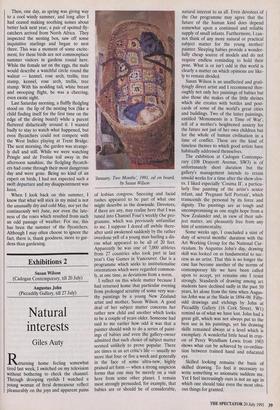Gardens
Lush places
Ursula Buchan
Our garden is set behind a village street and is of only medium size. Never- theless, through no virtue of our own (except perhaps the negative one of allow- ing undergrowth to flourish), it attracts a satisfactory variety of bird visitors to add to the resident population. From time to time we entertain goldfinches, spotted wood- peckers, bullfinches, house martins and, one extraordinary October day, a raven, which perched for an hour on the walnut tree before shambling off, Heaven knows where.
We also have more than our share of wood pigeons and collared doves, no doubt frightened off the cabbage-rich allotments behind the garden by a barrage of plastic supermarket bags. Tied to stakes by orange polypropylene baler twine — that most enduring and appealing accessory for the rural man — these billow in a crackling way in the softest breeze.
It would be interesting to discover which brand of plastic bag is the most unsettling to bird life. If I were a bird, I should cer- tainly steer clear of the one given away by Morrison's, for it has the same psychologi- cal effect as an angry wasp on me, (Those not fortunate enough to live in the Mid- lands or North may be unfamiliar with this supermarket chain's black and yellow logo, or indeed with the television advertisement which ends with the memorable jingle, 'More reasons to shop at Morreesons'.) It is my unscientific opinion that this bright white bag deters the birds more effectively than the brown and less glaring Sainsbury's bag. (Some of the latter, incidentally, carry the legend 'Age Concern', which indicates a sagacious self-interest on the part of the allotmenteers.) As if the garden did not have enough birds, therefore, the children have pestered me for some time to make them a nesting box, going so far as to show me books con- taining bright, cheerful and simplified illus- trations of one in the making. This spring, ashamed of my indolence but lacking the necessary spare bits of wood, I bought a flimsy-looking job for £1.29 at our local 'Pat-a-pet One-stop Animal Superstore'. I nailed it, askew, into the bark of the walnut tree.
Nothing happened. All spring the black- birds, starlings, tits and thrushes studiously ignored it and nested in the 'Albertine' and roof eaves as usual. Then, one day, as spring was giving way to a cool windy summer, and long after I had ceased making soothing noises about better luck next year, a pair of spotted fly- catchers arrived from North Africa. They inspected the nesting box, saw off some inquisitive starlings and began to nest there. This was a moment of some excite- ment, for these birds are not commonplace summer visitors in gardens round here. While the female sat on the eggs, the male would describe a watchful circle round the walnut — kennel, rose arch, trellis, tree stump, kennel, rose arch, trellis, tree stump. With his nodding tail, white breast and swooping flight, he was a cheering, even exotic sight.
Last Saturday morning, a fluffly fledgling stood on the lip of the nesting box (like a child finding itself for the first time on the edge of the diving board) while a parent fluttered didactically around it. I wanted badly to stay to watch what happened, but even flycatchers could not compete with the West Indies playing at Trent Bridge. The next morning, the garden was strange- ly dull and still. While we were watching Pringle and de Freitas toil away in the afternoon sunshine, the fledgling flycatch- ers had come through their most dangerous day and were gone. Being no kind of an expert on birds, I had not expected such a swift departure and my disappointment was keen.
When I look back on this summer, I know that what will stick in my mind is not the unusually dry and cold May, nor yet the continuously wet June, nor even the late- ness of the roses which resulted from such an odd passage of weather. For me, this has been the summer of the flycatchers. Although I may often choose to ignore the fact, there is, thank goodness, more to gar- dens than gardening.



















































 Previous page
Previous page